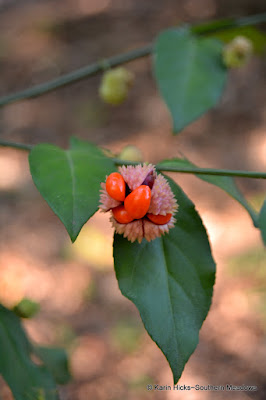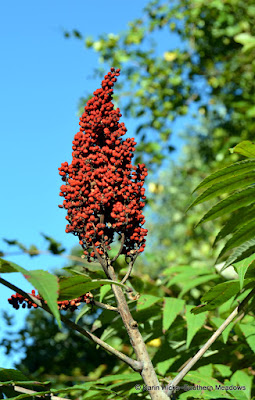October is in full swing with fall color just beginning to show itself. We've had some early leaf drop due to drought stress and it remains to be seen how dramatic our foliage display will be this year. Peak foliage in North Georgia falls between late October to early November. Nevertheless, ample color abounds around the garden.
Pollinators do the ground work here and all their buzzing and fluttering from bloom to bloom has paid off. Plants now adorn the seeds and fruits of their labor. Gardeners and landscape designers often choose perennial plants for
their foliage, bloom color, fragrance or shape. Another consideration is the value
perennials present to wildlife. Berries add pops of color and seed pods provide textural interest throughout the landscape, while providing food that will be consumed by birds and other mammals during the fall and winter months.
 |
| Mockingbird eating fruit from American Beautyberry shrub |
The clusters of bright purple fruit on American Beautyberry (Callicarpa americana) is a stunning accent in sunny areas. This shrub supports at least 10 species of birds, including cardinals, mockingbirds, woodpeckers, bluebirds, sparrows, wood thrushes and wild turkeys, who gobble up the fruit.
 |
| A closer look at the bodacious berries |
The pear shaped seed pods of the bottlebrush buckeye (Aesculus parviflora) shrub are popping open to reveal the pumpkin orange nuts (buckeyes), which are revered by chipmunks and squirrels. As soon as the protein rich buckeyes hit the ground they magically disappear as squirrels hastily carry them off. (Note: they are poisonous to humans and livestock).
 |
| Seasonally appropriate orange buckeye nuts |
Winterberry holly (Ilex verticillata) is not your average holly. It is deciduous, which shows off their berries (on female plants) when the leaves fall from the branches. We have two female 'Winter Gold' shrubs that are supported by the male 'Southern Gentleman'. Birds, such as Cedar Waxwings and American Robins, are eager to consume these bright berries. And if the birds don't get them first, rabbits, squirrels, foxes and deer will vacuum them up. It's possible for the berries to persist through the winter, if wildlife doesn't get them.
 |
| Winter Gold produces orange berries, a change of pace from the typical red |
Another showy berry comes from the Hearts-a-Bustin (Euonumus americanus) shrub. We grow these at the woodland edge where they enjoy the light shade of the understory habitat of the hardwood forest. These shrubs go unnoticed most of the year, but when the seed capsules burst open to reveal the bright red berries, they are show stoppers. Eastern bluebirds, wood thrushes, yellow-rumped warblers, northern mockingbirds and wild turkeys devour these berries and disseminate the seeds.
 |
| Bursting with love for these berries |
To see how the blooms of Hearts-a-Bustin' are pollinated, see my post
Ants, Unlikely Pollinators.
 |
| seed capsule opening to reveal orange/red berries |
Five species of viburnum grow at Southern Meadows, including viburnum dentatum, viburnum nudum 'winterhur' and 'brandywine', and viburnum obovatum. Viburnums light up the fall garden with their gorgeous foliage and lively berries.
 |
| Blue berries brighten autumn |
More recently we have added both red (Aronia arbutifolia) and black (Aronia melanocarpa) chokeberry shrubs to our flower beds. Our yet young shrubs, bloom in spring and once pollinated grow into lovely red or black berries that hang in pendulous clusters. Red berries are dazzling and persist through winter. Black berries are less apparent, unless observed close up. Few birds (robins and bluejays) enjoy the berries as they have a bitter taste, hence the common name.
 |
| young shrubs producing a few clusters of berries |
Sumac is not a tree intentionally found in most gardens, but it is most certainly a tree that should be included in more landscape plans. Fall is the time of year for this tree to standout with its dramatic foliage and bright berries. Several species, including winged, smooth and staghorn sumac, are found along woodland edges and roadsides in Georgia with berries that persist through the winter months, providing food for many songbirds.
 |
| Brilliant red sumac berries against bright blue sky |
Bluebirds, warblers, thrashers, chickadees, mockingbirds, woodpeckers, robins, cedar waxwings and thrushes will swallow the brilliant red berries whole, which they then inadvertently spread across the land.
 |
| red sumac berries are edible to humans and wildlife (white berries are toxic) |
You can't beat berries for bursts of color that persists through fall and winter. They last much longer than most blooms and the fruits and berries are a critical source of food for many birds, especially those that are migrating. Adding berry worthy plants will add visual interest and variety to your garden well into the winter months, but most importantly will support wildlife through the seasons.












